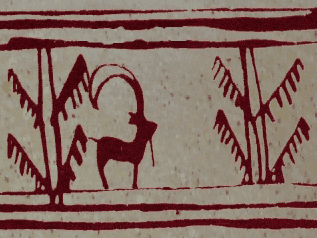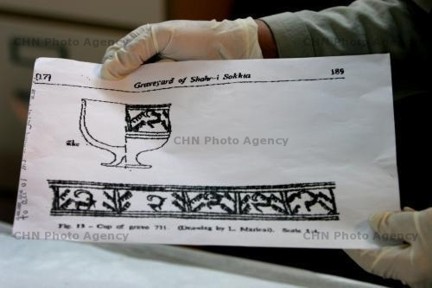La animación más antigua de la historia está representada en un cuenco persa de hace 5.200 años

Un cuenco de barrio cocido, de 5.200 años de antigüedad, tiene grabado en su exterior una serie de imágenes que, haciendo girar el cuenco sobre si mismo, muestran el movimiento de una cabra salvaje saltando para comer las hojas de un árbol. Lo que la convierte en la animación más antigua de la historia. Éste es el mismo sistema empleado para los zoótropos creados en el siglo XIX.
El cuenco fue descubierto en los años 70 por un equipo de arqueólogos italianos en el yacimiento arqueológico de Shahr-i Sokhta (que en persa significa ‘ciudad quemada'), en Irán, sin que entonces se dieran cuenta de la animación. Años más tarde, el Dr. Mansur Sadjadi, un arqueólogo iraní, descubrió la finalidad de la secuencia de imágenes. Y, recientemente, se ha producido un cortometraje documental que explica la historia y finalidad de este cuenco.
A raíz del estreno del documental, un grupo de expertos iraníes ha asociado el árbol grabado en el cuenco con el mito del Árbol de la Vida de los asirios, aunque no hay constancia de la presencia en aquel lugar de la civilización asiria hasta 1000 años después de la datación del cuenco. En contra de esta teoría, se encuentra el hecho de que se han descubierto en territorio iraní piezas con grabados de cabras salvajes con más de 6.000 años de antigüedad.

Fuente: The Circle of Ancient Iranian Studies
-
(2) CHTHO's Cultural Blunder and Documentary Production on World's Oldest Animation
LONDON, (CAIS) -- The Cultural Heritage, Tourism and Handicrafts Organization (CHTHO) announced on Monday that it has recently completed the production of a documentary about the ancient Iranian earthenware bowl bearing the world's oldest example of animation.
Directed by Mohsen Ramezani, the 11-minute film gives viewers an introduction to the bowl, which was discovered in a grave at the 5200-year-old Burnt City by an Italian archaeological team in late 1970s.
The artefact bears five images depicting a wild goat jumping up to eat the leaves of a tree, which the members of the team at that time had not recognised the relationship between the pictures.
Several years later, Iranian archaeologist Dr Mansur Sadjadi, who became later appointed as the new director of the archaeological team working at the Burnt City discovered that the pictures formed a related series.
Nonetheless, according to English daily Mehr, during a ceremony held on Sunday to promote the production, CHTHO's cultural authorities claimed the image is a depiction of ‘Assyrian Tree of Life': "the earthenware bowl, which is wrongly known as ‘The Burnt City's goat', depicts the myth of ‘The Assyrian Tree of Life' and a goat."

Depiction of ‘The Assyrian Tree of Life' on this bowl which was made at least 1000 years before the Assyrian civilisation even appear in historical records is one of the most preposterous claims by the new-breed of experts in post-revolutionary Iran.
The image is a simple depiction of a tree and wild-goat (Capra aegagrus) also known as 'Persian desert Ibex', and since it is an indigenous animal to the region, it would naturally appear in the iconography of the Burnt City.
The wild goat motif can be seen on Iranian pottery dating back to the 4th millennium BCE, as well as jewellery pieces especially among Cassite tribes of ancient Luristan. However, the oldest wild goat representation in Iran was discovered in Negaran Valley in Sardast region, 37 kilometers from Nahok village near Saravan back in 1999. The engraved painting of wild goat is part of an important collection of lithoglyphs dating back to 8000 BCE.
However, wild goat representation with a tree is associated with Murkum, a mother goddess who was worshipped by all the Indo-Iranian women of the Haramosh valley in modern Pakistan, which culturally had closer ties with Indus and subsequently the Burnt City civilisations, than Mesopotamia, which could had influenced the ancient potter who made this unique piece.
Source: Mehr News Agency

Ver Animación:
2 comentarios
Alvaro Garrido -
JORGE HUGO BERTRAN VALL -